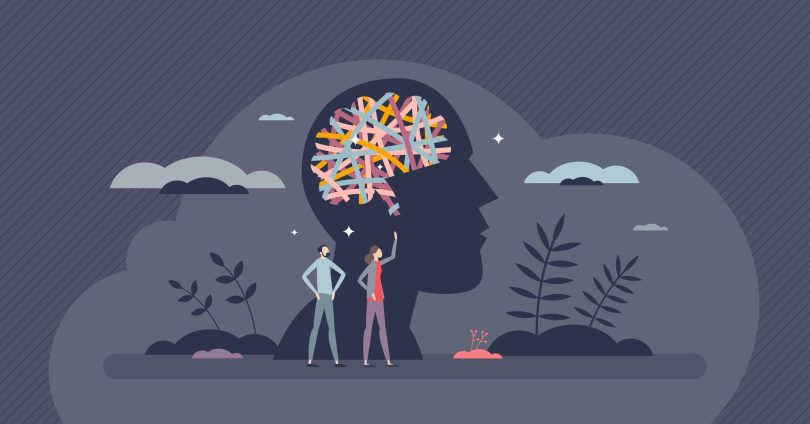In his monthly column, our resident therapist and coach, James Jackson, helps you navigate personal & professional roadblocks with insight and guidance.
Stop The Spin
Hi James,
One thing that I struggle with is stopping my mind from overthinking. I often find myself thinking about one thing, and then my mind wanders to other unrelated thoughts, causing me to get lost in them and making it difficult to focus on just one thing. What would your advice be for this situation?
Kind regards,
David
Dear David,
Thank you for your letter. I’d love to start this response by saying that I need to know more about you—your age, context, psycho-emotional state, sleep patterns, diet, financial comfort—but the beautiful thing is that it’s not important. That’s not to say these life factors don’t play an important role in our thought patterns; they do, but they are often misplaced and misunderstood within the equation. Our thoughts → create our feelings → which inform our behaviours → which, in turn, dictate our events. It’s this chain of command that’s very easy to get lost in. Every second of our waking and sleeping state is spent somewhere on this production line of what we call our internal experience. We then receive feedback loops from the outside world, which further complicates, enriches, and confuses our internal cognitive process.
What is a Thought?
Thoughts are pieces of data—nothing more, nothing less. Some are extremely useful, while others are like annoying internet pop-up ads: brightly coloured windows that appear in a flash and scream until they are either acted upon or shut down. Sometimes, when trying to shut them down, we accidentally activate them, bringing a cascade of other pop-up windows. Sound familiar? Some of these thoughts can appear so bright and strong that we think they must be important, so they get triaged into the “important” category and placed on the train track. Destination? Events! Passing through feelings and behaviours en route!
Our brilliant brains, over time, want to short-circuit and optimise this process. Your brain, like all computers, rewrites the code to find the fastest way from point A to point B. Its primary goal is your survival, not your happiness. It does this by creating beliefs. It hardwires these high-emotion codes that set a suite of default programmes, which either encourage or refrain you from experiencing a certain outcome. It’s in the rewriting of these programmes that you can truly transform your life and take back control of the motherboard.

The Triage Nurse
When you go to A&E (or the emergency room), the first person you’ll see is a triage nurse. Their job is to categorise the urgency of cases and set up the consultations accordingly. In essence, we are our own cognitive triage nurse, but to do this effectively, we must develop the ability to step outside of the thought production room and into the triage room. In order to carry out informed triage, we must order our thoughts into categories and understand the feeling responses they either create or are propelled by.
The 17 Thought Categories
- Positive Thoughts
Associated with optimism, gratitude, or happiness.
Example: “I can handle this challenge and learn from it.” - Negative Thoughts
Linked to worry, doubt, or pessimism.
Example: “I always mess things up.” - Automatic Thoughts
Unconscious and habitual thoughts triggered by daily experiences.
Example: “I forgot my umbrella; now the day is ruined.” - Critical Thoughts
Self-judging or evaluating oneself negatively.
Example: “I’m not good enough for this job.” - Creative Thoughts
Involve generating new ideas, solutions, or perspectives.
Example: “How can I design this differently to make it stand out?” - Ruminating Thoughts
Repetitive and focused on distressing topics, often unhelpful.
Example: “Why did I say that? I must have sounded so stupid.” - Constructive Thoughts
Problem-solving or planning thoughts aimed at improvement.
Example: “What steps can I take to improve my skills?” - Daydreaming Thoughts
Imaginative or fantasy-based, often unrelated to the present moment.
Example: “What if I moved to another country and started fresh?” - Analytical Thoughts
Logical and detail-oriented, used for reasoning and evaluation.
Example: “If I take this route, it will save me 10 minutes.” - Anxious Thoughts
Focused on future uncertainties and potential dangers.
Example: “What if I fail the presentation tomorrow?” - Intrusive Thoughts
Unwanted, involuntary thoughts, often distressing or inappropriate.
Example: “What if I trip while walking on stage?” - Mindful Thoughts
Focused on the present moment, with awareness and acceptance.
Example: “I feel the warmth of the sun on my skin right now.” - Logical Thoughts
Based on facts and reason.
Example: “If I save money this month, I can afford the trip.” - Emotional Thoughts
Driven by feelings rather than logic.
Example: “I feel upset, so I can’t think straight.” - Obsessive Thoughts
Persistent and recurrent thoughts that can dominate the mind.
Example: “They’ve read my text message but are not responding.” - Big Picture Thoughts
Focused on overarching goals or life direction.
Example: “What do I want to achieve in the next five years?” - Small Detail Thoughts
Concerned with specific, immediate aspects of a situation.
Example: “I need to organise my files today.”
It might appear intimidating to see this list. I understand, but the plot thickens! A clinical study performed by Tseng, K. K., et al. (2020), The Dynamics of Thought: Measuring Transitions in Ongoing Thought Streams, revealed using Functional Magnetic Resonance Imaging (fMRI) that the average human brain switches to a
new thought 6,000 times per day. A study by the National Science Foundation (2005) purports that 80% of thoughts are repetitive and 95% are the same as the previous day. I’d like to caveat that these percentages – although often cited online – are not currently backed up by clinical trial research.
Your Brain Accepts Commands
In fact, it begs for commands. It loves commands. Your brain is the most powerful thing on this planet, but it needs clear instruction. In the absence of such, it will compute and derive its own instructions based on data at hand and previous programmes that it has hardwired in the form of beliefs (e.g. “I am not able to order my own thoughts or concentrate, and that means there’s something wrong with me, and that makes me feel helpless and out of control”).
With this belief in place, the brain responds: “OK, so in your case, David, I’ll take FULL control! And so as not to miss a really important thought, I’ll give equal bandwidth to them all, whenever they come in! Without your ability to instruct me otherwise, and without a triage nurse, I’ll just do everything, really fast, in the order that things arrive, because I’m a Ferrari and I love to stretch my legs on the open road!”
For most people, the commands are delivered in the form of communicative directives we give to ourselves, or what therapists refer to as “self-talk”. It seems to me that your triage nurse is having difficulty knowing which thoughts to throw away and which ones to take seriously. Here’s the hack: don’t look at the thoughts, look at what propels them or feeds them – the feelings. It appears in your case that you are struggling with a cocktail of ‘emotional’, ‘automatic’, and perhaps ‘small detail’ or ‘intrusive’ thoughts.
What will be very helpful in your case, David, is to first identify the thoughts that are fuelled with high emotion. Let’s collect some data! But before we get started, I want you to repeat the following statements:
- “I am perfectly normal.”
- “My brain is not broken.”
- “I can start, stop, change, and reject thoughts in a nanosecond with the right self-talk.”
- “I can change my core beliefs with diligence, the right tools, and the right guidance.”
The Experiment
Here’s what I suggest, David. You don’t need to buy a fancy app or write in a paper journal (although meditation will help you gain clarity in this experiment). You need just two things: The 17 Thought Categories listed above and your phone. I want you to start a conversation with yourself in WhatsApp. Three times per day for one week, I want you to sit quietly for two minutes, then write or send a voice note to yourself describing your current thought landscape. In each message/recording, highlight the five thought categories in the list that are showing up the most. Then, record in the voice note:
“Of all the thoughts I’m having, the one that keeps showing up is ________ & that makes me feel ________ & the reason it makes me feel that is because ________”
At the end of the week, play back the messages to yourself, and you’ll start to see insightful patterns.
Your feelings are the fuel of your thoughts, David. These are the thoughts that you must first understand and deal with to live a free life with more agency. Sometimes, when certain feelings are too difficult, our brain encourages tsunamis of other thoughts – a sort of noise pollution – to drown out the others.
When you’ve carried out the week-long experiment, David, feel free to send me an email with your findings, and I will gladly point you in the right direction with the best tools and next steps for you.
The ability to step outside of one’s brain and look back in takes a little time and patience to learn, but it is accessible to all. You are well on your path to becoming a mind master with a sharp, accurate, and loving triage nurse who knows you better than anyone!
I hope this helps, David. Take care… & remember, thoughts are just data, but the feelings are their fuel!
James
Further Reading:
References:
Tseng, K. K., et al. (2020). The Dynamics of Thought: Measuring Transitions in Ongoing Thought Streams.
Note: Any advice provided in ‘Ask James’ is intended for informational and general guidance purposes only. It is not a substitute for professional medical, psychological, or legal services. Readers are encouraged to consult a licensed professional for personalised advice or treatment specific to their situation. All letters are anonymised to protect privacy unless explicit consent is provided to include identifiable details. By submitting a question, you agree to its potential publication in anonymised form, unless you explicitly request otherwise. Advice is offered within the scope of James’ expertise, and all health-related claims are verified with credible sources to ensure accuracy. If your submission is selected for publication, you will be notified by email before it is published. Due to the volume of submissions, we cannot guarantee a response to every letter. However, priority will be given to topics that resonate with a broad audience of readers.
Main – Photos by Getty Images



